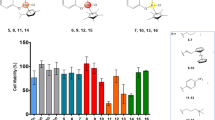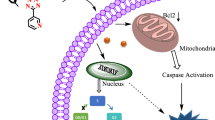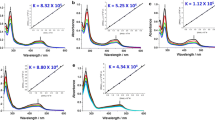Abstract
Ruthenium (Ru) and osmium (Os) complexes are of sustained interest in cancer research and may be alternative to platinum-based therapy. We detail here three new series of ruthenium and osmium complexes, supported by physico-chemical characterizations, including time-dependent density functional theory, a combined experimental and computational study on the aquation reactions and the nature of the metal–arene bond. Cytotoxic profiles were then evaluated on several cancer cell lines although with limited success. Further investigations were, however, performed on the most active series using a genetic approach based on RNA interference and highlighted a potential multi-target mechanism of action through topoisomerase II, mitotic spindle, HDAC and DNMT inhibition.
Graphic abstract






Similar content being viewed by others
Availability of data and material
Crystal structures have been filed in the Cambridge Crystallographic Data Centre (CCDC). Deposit numbers: 2061654 for RuAEM and 2061655 for OsAEM.
References
Rosenberg B, Van Camp L, Krigas T (1965) Inhibition of cell division in Escherichia coli by electrolysis products from a platinum electrode. Nature 205:698–699. https://doi.org/10.1038/205698a0
Galluzzi L, Senovilla L, Vitale I et al (2012) Molecular mechanisms of cisplatin resistance. Oncogene 31:1869–1883. https://doi.org/10.1038/onc.2011.384
Florea A-M, Büsselberg D (2011) Cisplatin as an anti-tumor drug: cellular mechanisms of activity, drug resistance and induced side effects. Cancers (Basel) 3:1351–1371. https://doi.org/10.3390/cancers3011351
Trondl R, Heffeter P, Kowol CR et al (2014) NKP-1339, the first ruthenium-based anticancer drug on the edge to clinical application. Chem Sci 5:2925–2932. https://doi.org/10.1039/c3sc53243g
Leijen S, Burgers SA, Baas P et al (2015) Phase I/II study with ruthenium compound NAMI-A and gemcitabine in patients with non-small cell lung cancer after first line therapy. Invest New Drugs 33:201–214. https://doi.org/10.1007/s10637-014-0179-1
Meier-Menches SM, Gerner C, Berger W et al (2018) Structure–activity relationships for ruthenium and osmium anticancer agents—towards clinical development. Chem Soc Rev. https://doi.org/10.1039/C7CS00332C
Aird RE, Cummings J, Ritchie AA et al (2002) In vitro and in vivo activity and cross resistance profiles of novel ruthenium(II) organometallic arene complexes in human ovarian cancer. Br J Cancer 86:1652–1657. https://doi.org/10.1038/sj/bjc/6600290
Scolaro C, Bergamo A, Brescacin L et al (2005) In vitro and in vivo evaluation of ruthenium(II)–arene PTA complexes. J Med Chem 48:4161–4171. https://doi.org/10.1021/jm050015d
Peacock AFA, Habtemariam A, Ferna R et al (2006) Tuning the reactivity of osmium (II) and ruthenium (II) arene complexes under physiological conditions. J Am Chem Soc 128:1739–1748
Zhang P, Sadler PJ (2017) Advances in the design of organometallic anticancer complexes. J Organomet Chem 839:5–14. https://doi.org/10.1016/j.jorganchem.2017.03.038
Needham RJ, Sanchez-Cano C, Zhang X et al (2017) In-cell activation of organo-osmium(II) anticancer complexes. Angew Chemie Int Ed 56:1017–1020. https://doi.org/10.1002/anie.201610290
Flocke LS, Trondl R, Jakupec MA, Keppler BK (2016) Molecular mode of action of NKP-1339—a clinically investigated ruthenium-based drug—involves ER- and ROS-related effects in colon carcinoma cell lines. Invest New Drugs 34:261–268. https://doi.org/10.1007/s10637-016-0337-8
Gifford JB, Huang W, Zeleniak AE et al (2016) Expression of GRP78, master regulator of the unfolded protein response, increases chemoresistance in pancreatic ductal adenocarcinoma. Mol Cancer Ther 15:1043–1052. https://doi.org/10.1158/1535-7163.MCT-15-0774
Neuditschko B, Legin AA, Baier D et al (2021) Interaction with ribosomal proteins accompanies stress induction of the anticancer metallodrug BOLD-100/KP1339 in the endoplasmic reticulum. Angew Chemie Int Ed 60:5063–5068. https://doi.org/10.1002/anie.202015962
Meier SM, Kreutz D, Winter L et al (2017) An organoruthenium anticancer agent shows unexpected target selectivity for plectin. Angew Chemie Int Ed 56:1–6. https://doi.org/10.1002/anie.201702242
Dong B, Song X, Kong X et al (2017) A tumor-targeting and lysosome-specific two-photon fluorescent probe for imaging pH changes in living cells. J Mater Chem B 5:988–995. https://doi.org/10.1039/c6tb02957d
Andrew CL, Klemm AR, Lloyd JB (1997) Lysosome membrane permeability to amines. Biochim Biophys Acta Biomembr 1330:71–82. https://doi.org/10.1016/S0005-2736(97)00145-4
Fu Y, Habtemariam A, Pizarro AM et al (2010) Organometallic osmium arene complexes with potent cancer cell cytotoxicity. J Med Chem 53:8192–8196. https://doi.org/10.1021/jm100560f
Piao S, Amaravadi RK (2016) Targeting the lysosome in cancer. Ann N Y Acad Sci 1371:45–54. https://doi.org/10.1111/nyas.12953
Fehrenbacher N, Jäättelä M (2005) Lysosomes as targets for cancer therapy. Cancer Res 65:2993–2995. https://doi.org/10.1158/0008-5472.CAN-05-0476
Casini A, Gabbiani C, Sorrentino F et al (2008) Emerging protein targets for anticancer metallodrugs: inhibition of thioredoxin reductase and cathepsin B by antitumor ruthenium(II)-arene compounds. J Med Chem 51:6773–6781. https://doi.org/10.1021/jm8006678
Mokesch S, Schwarz D, Hejl M et al (2019) Fine-tuning the activation mode of an 1,3-Indandione-based ruthenium(II)-Cymene half-sandwich complex by variation of its leaving group. Molecules 24:1–15. https://doi.org/10.3390/molecules24132373
Hao L, Zhong Y-M, Tan C-P, Mao Z-W (2021) Acidity-responsive phosphorescent metal complexes for cancer imaging and theranostic applications. J Organomet Chem. https://doi.org/10.1016/j.jorganchem.2021.121821
Ren W, Han J, Uhm S et al (2015) Recent development of biotin conjugation in biological imaging, sensing, and target delivery. Chem Commun 51:10403–10418. https://doi.org/10.1039/C5CC03075G
Muhammad N, Sadia N, Zhu C et al (2017) Biotin-tagged platinum(IV) complexes as targeted cytostatic agents against breast cancer cells. Chem Commun 53:9971–9974. https://doi.org/10.1039/c7cc05311h
Jin S, Guo Y, Song D et al (2019) Targeting energy metabolism by a platinum(IV) prodrug as an alternative pathway for cancer suppression. Inorg Chem 58:6507–6516. https://doi.org/10.1021/acs.inorgchem.9b00708
Babak MV, Plażuk D, Meier SM et al (2015) Half-sandwich ruthenium(II) biotin conjugates as biological vectors to cancer cells. Chemistry 21:5110–5117. https://doi.org/10.1002/chem.201403974
Côrte-Real L, Karas B, Brás AR et al (2019) Ruthenium-cyclopentadienyl bipyridine-biotin based compounds: synthesis and biological effect. Inorg Chem 58:9135–9149. https://doi.org/10.1021/acs.inorgchem.9b00735
Teixeira RG, Belisario DC, Fontrodona X et al (2021) Unprecedented collateral sensitivity for cisplatin-resistant lung cancer cells presented by new ruthenium organometallic compounds. Inorg Chem Front. https://doi.org/10.1039/d0qi01344g
Martin A. Bennett and Anthony K. Smith (1974) Arene ruthenium (II) complexes formed by dehydrogenation of Cyclo-. J Chem Soc Dalt Trans 0:233–241
Stahl SWH (1990) A new family of (arene)osmium(0) and -osmium(II) complexes. Organometallics 9:1876–1881
Peacock AFA, Habtemariam A, Moggach SA et al (2007) Chloro half-sandwich osmium (II) complexes: influence of chelated N, N-ligands on hydrolysis, guanine binding, and cytotoxicity. Inorg Chem 46:2966–2967. https://doi.org/10.1021/ic062350d
Morris RE, Aird RE, Del Socorro MP et al (2001) Inhibition of cancer cell growth by ruthenium(II) arene complexes. J Med Chem 44:3616–3621. https://doi.org/10.1021/jm010051m
Higgins B, DeGraff BA, Demas JN (2005) Luminescent transition metal complexes as sensors: structural effects on pH response. Inorg Chem 44:6662–6669. https://doi.org/10.1021/ic050044e
Chai J-D, Head-Gordon M (2008) Long-range corrected hybrid density functionals with damped atom-atom dispersion corrections. Phys Chem Chem Phys 10:6615–6620. https://doi.org/10.1039/b810189b
Weigend F, Ahlrichs R (2005) Balanced basis sets of split valence, triple zeta valence and quadruple zeta valence quality for H to Rn: design and assessment of accuracy w. Phys Chem Chem Phys 7:3297–3305
Weigend F (2006) Accurate Coulomb-fitting basis sets for H to Rn. Phys Chem Chem Phys 8:1057–1065. https://doi.org/10.1039/b515623h
Van LE, Baerends EJ, Snijders JG (1993) Relativistic regular two-component Hamiltonians. J Chem Phys 99:4597. https://doi.org/10.1063/1.466059
Glendening ED, Badenhoop JK, Reed AE et al (2013) NBO 6.0. Theor Chem Institute, Univ Wisconsin, Madison
Klose MHM, Hejl M, Heffeter P et al (2017) Post-digestion stabilization of osmium enables quantification by ICP-MS in cell culture and tissue. Analyst 142:2327–2332. https://doi.org/10.1039/c7an00350a
Berger G, Grauwet K, Zhang H et al (2018) Anticancer activity of osmium(VI) nitrido complexes in patient-derived glioblastoma initiating cells and in vivo mouse models. Cancer Lett 416:138–148. https://doi.org/10.1016/j.canlet.2017.11.041
Jiang H, Pritchard JR, Williams RT et al (2010) A mammalian functional-genetic approach to characterizing cancer therapeutics. Nat Chem Biol 7:1–9. https://doi.org/10.1038/nchembio.503
Pritchard JR, Bruno PM, Hemann MT, Lauffenburger DA (2013) Predicting cancer drug mechanisms of action using molecular network signatures. Mol Biosyst 9:1604–1619. https://doi.org/10.1039/c2mb25459j
Pritchard JR, Bruno PM, Gilberta LA et al (2013) Defining principles of combination drug mechanisms of action. PNAS. https://doi.org/10.1073/pnas.1210419110
Landázuri N, Le Doux JM (2006) Complexation with chondroitin sulfate C and polybrene rapidly purifies retrovirus from inhibitors of transduction and substantially enhances gene transfer. Biotechnol Bioeng 93:146–158. https://doi.org/10.1002/bit.20697
Bevernaegie R, Marcélis L, Laramée-Milette B et al (2018) Trifluoromethyl-substituted iridium(III) complexes: from photophysics to photooxidation of a biological target. Inorg Chem 57:1356–1367. https://doi.org/10.1021/acs.inorgchem.7b02778
Wang D, Lippard SJ (2005) Cellular processing of platinum anticancer drugs. Nat Rev Drug Discov 4:307–320. https://doi.org/10.1038/nrd1691
Marloye M, Berger G, Gelbcke M, Dufrasne F (2016) A survey of the mechanisms of action of anticancer transition metal complexes. Future Med Chem. https://doi.org/10.4155/fmc-2016-0153
Betanzos-lara S, Novakova O, Deeth RJ et al (2012) Bipyrimidine ruthenium (II) arene complexes: structure, reactivity and cytotoxicity. J Biol Inorg Chem 17:1033–1051. https://doi.org/10.1007/s00775-012-0917-9
Wang F, Chen H, Parsons S et al (2003) Kinetics of aquation and anation of ruthenium(II) arene anticancer complexes, acidity and X-ray structures of aqua adducts. Chem A Eur J 9:5810–5820. https://doi.org/10.1002/chem.200304724
Popp J, Hanf S, Hey-Hawkins E (2019) Facile arene ligand exchange in p-cymene ruthenium(II) complexes of tertiary P-chiral ferrocenyl phosphines. ACS Omega 4:22540–22548. https://doi.org/10.1021/acsomega.9b03251
Sullivan MP, Nieuwoudt MK, Bowmaker GA et al (2018) Unexpected arene ligand exchange results in the oxidation of an organoruthenium anticancer agent: the first X-ray structure of a protein–Ru(carbene) adduct. Chem Commun. https://doi.org/10.1039/C8CC02433B
Hubig SM, Lindeman SV, Kochi JK (2000) Charge-transfer bonding in metal-arene coordination. Coord Chem Rev 200–202:831–873. https://doi.org/10.1016/S0010-8545(00)00322-2
Adeniyi AA, Ajibade PA (2013) Insights into the intramolecular properties of η 6-arene-Ru-based anticancer complexes using quantum calculations. J Chem. https://doi.org/10.1155/2013/892052
Bruno PM, Liu Y, Park GY et al (2017) A subset of platinum-containing chemotherapeutic agents kills cells by inducing ribosome biogenesis stress. Nat Med 23:461–471. https://doi.org/10.1038/nm.4291
Zheng YR, Suntharalingam K, Bruno PM et al (2016) Mechanistic studies of the anticancer activity of an octahedral hexanuclear Pt(II) cage. Inorganica Chim Acta 452:125–129. https://doi.org/10.1016/j.ica.2016.03.021
Suntharalingam K, Johnstone TC, Bruno PM et al (2013) Bidentate ligands on osmium(VI) nitrido complexes control intracellular targeting and cell death pathways. J Am Chem Soc 135:14060–14063. https://doi.org/10.1021/ja4075375
Bruno PM, Lu M, Dennis KA et al (2020) The primary mechanism of cytotoxicity of the chemotherapeutic agent CX-5461 is topoisomerase II poisoning. Proc Natl Acad Sci USA 117:4053–4060. https://doi.org/10.1073/pnas.1921649117
Acknowledgements
M.M. thanks Sabrina Cauchies for the ICP-MS experiments.
Author information
Authors and Affiliations
Contributions
MM and GB conceived and designed the research program. JRP, HI and CJM participated the shRNA experiments. The manuscript was written by MM and GB with contributions from all the authors. MM prepared all figures.
Corresponding author
Ethics declarations
Conflict of interest
The authors declare no competing financial interests.
Additional information
Publisher's Note
Springer Nature remains neutral with regard to jurisdictional claims in published maps and institutional affiliations.
Supplementary Information
Below is the link to the electronic supplementary material.
Rights and permissions
About this article
Cite this article
Marloye, M., Inam, H., Moore, C.J. et al. Synthesis, structure and anticancer properties of new biotin- and morpholine-functionalized ruthenium and osmium half-sandwich complexes. J Biol Inorg Chem 26, 535–549 (2021). https://doi.org/10.1007/s00775-021-01873-9
Received:
Accepted:
Published:
Issue Date:
DOI: https://doi.org/10.1007/s00775-021-01873-9




